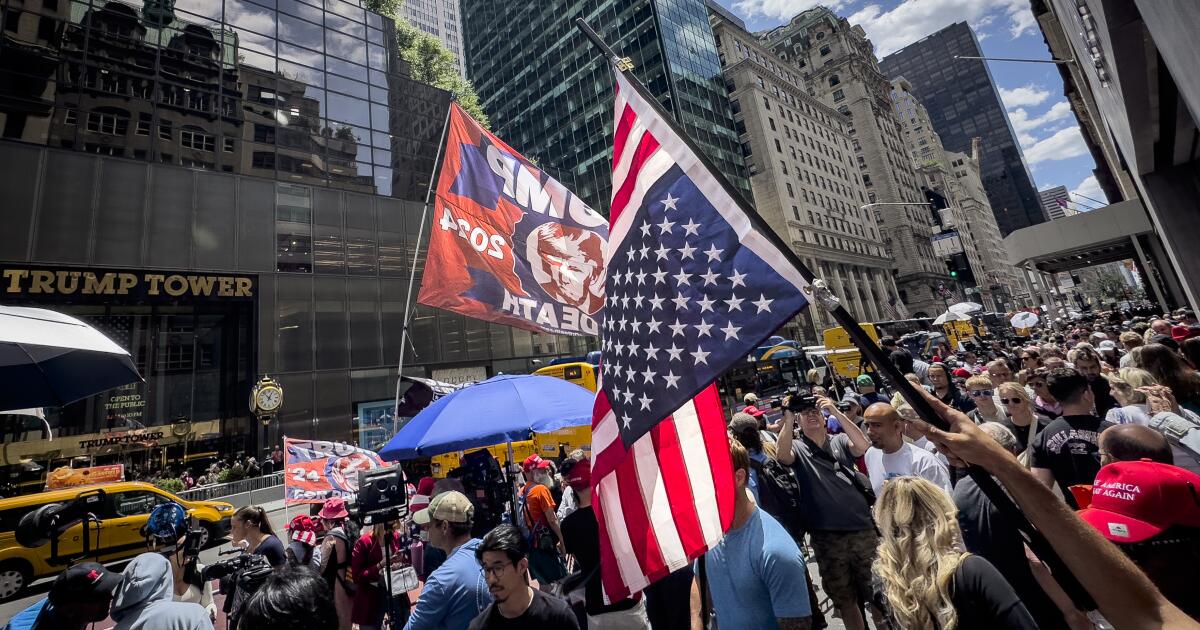Remember when then-Vice President Mike Pence staged a walkout of a football game because players took a knee during the national anthem to protest racism, saying he would not “dignify” disrespect to the flag? Or when President Trump said anyone kneeling in protest should be fired or maybe even deported?
Those bursts of performative outrage were typical of the Trump years, when some of the world’s most powerful politicians professed to take personal offense as others exercised their constitutional right to peaceful protest when they didn’t agree with the message.
But now that Trump supporters are using the inverted flag in protest, the indignation from Republican leaders is nowhere in sight.
Friday is Flag Day, when the nation commemorates the United States’ adoption of the Stars and Stripes as its official flag 247 years ago.
It’s a good occasion to remember that although what one considers disrespectful to the American flag depends on personal and political views, we all have the constitutionally protected freedom to use the flag any way we choose.
Although the U.S. Flag Code has a lengthy section on respect for the flag that says it should never be displayed upside down, “except as a signal of dire distress in instances of extreme danger to life or property,” it’s unenforceable. The code also says the flag should never have “any mark, insignia, letter, word, figure, design, picture, or drawing of any nature,” but that doesn’t prevent anyone from displaying U.S. flags emblazoned with political images, names, or slogans such as “Make America Great Again,” and “Let’s Go Brandon.”
Using the American flag for protest has deep roots. It was trampled and burned by Southerners to protest Abraham Lincoln in the Civil War era. It was displayed upside down by antislavery activists in the 1800s, by Vietnam War protesters in the 1960s and during the 2020 racial equity protests sparked by the police murder of George Floyd.
But more recently, the far right has embraced the inverted flag as symbol of election denial and fealty to Trump — a fact that gained new prominence after revelations that it flew outside Supreme Court Justice Samuel A. Alito Jr.’s home in the weeks after the Jan. 6 attack on the U.S. Capitol.
Alito blamed his wife, Martha-Ann, saying it was hung as part of a dispute with their neighbors, who had put up an anti-Trump yard sign. At the time, Trump supporters had begun using the inverted flag to signal their support for the “Stop the Steal” effort. Capitol rioters carried it during the Jan. 6 insurrection as they tried to overturn the 2020 election results, and Trump supporters continue to wave upside-down flags, including to protest his felony conviction in the New York hush money trial last month.
After Trump was found guilty of 34 counts, GOP leaders such as Rep. Marjorie Taylor Greene (R-Ga.), Republican National Committee co-chair Lara Trump and Donald Trump Jr. shared images of upside-down flags online. It flew outside the conservative Heritage Foundation in Washington. And others warned on social media of a coming “civil war” or posted “RIP America.”
Old Glory is a charged symbol and Americans’ relationship with it changes dynamically with the times and political winds, from its triumphant raising over the remains of Ft. Sumter in 1865 to the aggressively patriotic burst of American flags that emerged after the Sept. 11 terrorist attacks.
We live in an ostensibly free country, and anyone, even a Supreme Court justice (or his wife), has the right to fly the Star-Spangled Banner upside down or even burn it if they choose to. Both of those rights were upheld as protected symbolic speech by the Supreme Court.
But it is sheer hypocrisy to denounce others engaging with the flag in protest only to do the same thing and call it patriotism.


Your article helped me a lot, is there any more related content? Thanks!